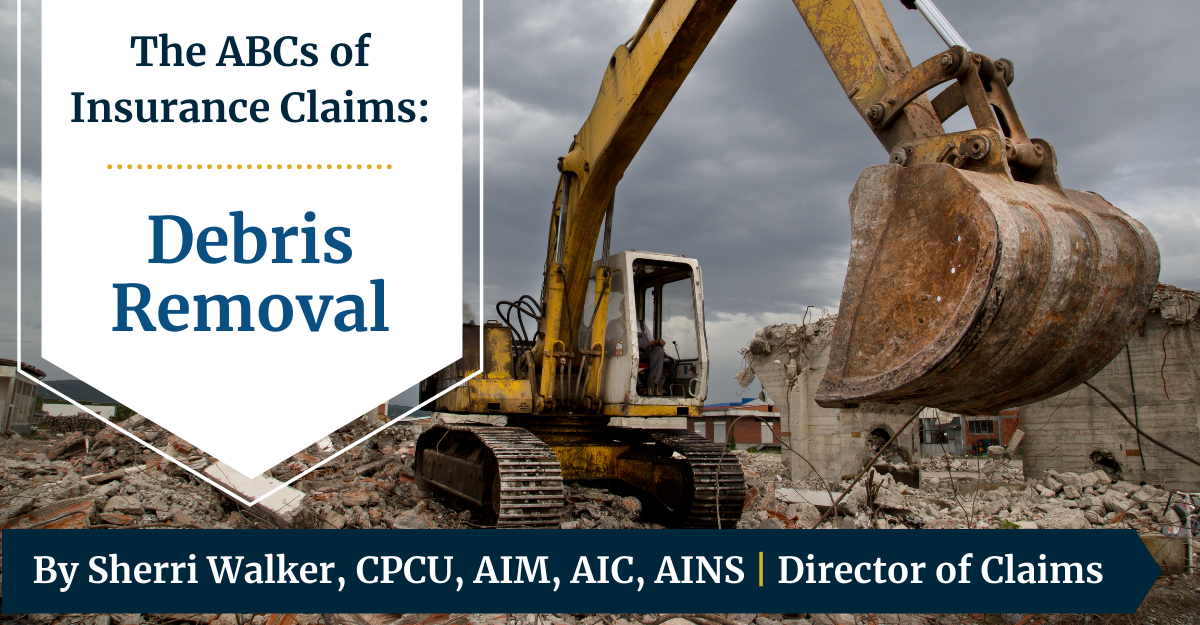Welcome to the ABCs of Insurance Claims. Over the next few months, Sherri Walker, Sentinel’s Director of Claims will address an aspect of claims handling for every letter of the alphabet to help provide a better understanding of the claims process.
Consider Debris Removal Costs
When someone suffers property loss due to severe wind, water, storm or fire event, there are a lot of daunting tasks to be completed. Before a loss occurs, there is often thought given to what it would take to replace or repair damaged property and the financial impacts that come with it.
When purchasing insurance, the consumer’s focus is on what the cost of construction or goods would be, especially for those who have never been through a significant claim before. While the restoration cost is absolutely at the basis of why policies are written, many people do not consider the logistical side of dealing with damaged property, specifically debris removal.
When we consider the cost to rebuild a total loss home or building, it is easy to forget that what is left of the existing damaged structure will have to be demolished and removed. Those costs can quickly add up, so it is important to address that exposure when determining the amount of coverage needed.
Defining Debris Removal
There are varying aspects to debris removal. It can be as simple as having a fallen tree removed due to a storm, or as complex as taking down structural components damaged by a fire that cannot be reused. Starting simply with trees and yard debris, it is important to know that there are sublimits to coverage available under most Homeowner’s coverage forms, but there are conditions involved.
For example, to cover the cost of removing a tree from your premises on a Homeowner’s form, the tree will have to fall on a covered structure or walkway to trigger coverage. A tree that falls in your yard that does not land on anything covered typically will not have any debris removal coverage available. If a tree does land on your home, fence or driveway, there will be a per tree and maximum limit available to haul the debris away based on your specific coverage form.
For non-tree related debris removal under your Homeowner’s policy, there is a coverage limitation for debris removal that is either a named amount or percentage of the total loss amount available. There may also be a coverage extension under some forms that will add 5% of the building coverage for debris removal, but only if the building coverage is exhausted.
Most commercial property policies also cover debris removal in the same manner as a Homeowner’s form, at a percentage of the loss total. Many commercial policies will also carry up to an extra $25,000 if your debris removal exceeds the amount of coverage available and your policy limits are exceeded. Additionally, there are endorsements available to add coverage in circumstances that may require higher limits.
Debris Removal Policy Coverage
Key elements to keep in mind when adding Debris Removal coverage to your policy:
- To trigger the coverage, the debris must be a result of a covered cause of loss to be insurable.
- Debris removal coverage specifically excludes pollution and clean-up of pollutants. Those coverages would be available under separate endorsement.
- There is a time limit to present debris removal. It must be presented within 180 days of the loss for coverage. It is also important to know that the coverage does not cover the costs of removing property you own but do not insure, or that belongs to someone else and does not fall into the same class of property covered by your policy.
While it can be challenging to make sure you have adequate coverage in place to address debris removal and similar exposures, our team of specialists at Sentinel are here to review your policy with you and make any needed changes to make sure you are protected in the event of a loss.


